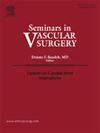女性胸廓出口综合征
IF 2.4
3区 医学
Q1 PERIPHERAL VASCULAR DISEASE
引用次数: 0
摘要
胸廓出口综合征(TOS)在女性中更为常见,但造成这种性别差异的确切原因仍不清楚。本文通过研究三种类型的 TOS(动脉型、神经源型和静脉型)在症状、诊断和治疗方面的情况,旨在阐明目前对 TOS 的认识,重点关注其在女性中的变化。本文章由计算机程序翻译,如有差异,请以英文原文为准。
Thoracic outlet syndrome in women
Thoracic outlet syndrome (TOS) is observed more frequently in women, although the exact causes of this sex disparity remain unclear. By investigating the three types of TOS—arterial, neurogenic, and venous—regarding symptoms, diagnosis, and treatment, this article aims to shed light on the current understanding of TOS, focusing on its variations in women.
求助全文
通过发布文献求助,成功后即可免费获取论文全文。
去求助
来源期刊
CiteScore
3.50
自引率
4.00%
发文量
54
审稿时长
50 days
期刊介绍:
Each issue of Seminars in Vascular Surgery examines the latest thinking on a particular clinical problem and features new diagnostic and operative techniques. The journal allows practitioners to expand their capabilities and to keep pace with the most rapidly evolving areas of surgery.

 求助内容:
求助内容: 应助结果提醒方式:
应助结果提醒方式:


